PCBU Application: WHS Risk Assessment in Biscuit Manufacturing Unit
VerifiedAdded on 2023/06/15
|6
|1505
|265
Report
AI Summary
This report provides a detailed overview of a Workplace Health and Safety (WHS) risk assessment conducted in a biscuit manufacturing company. The primary objective was to explain the safety and hazard management approach applied within the manufacturing plant, with a focus on the application of the PCBU (Person Conducting Business or Undertaking) process. The report identifies various hazards present in the biscuit manufacturing environment, including biological, chemical, and physical risks associated with processes such as baking, cooling, and material handling. The PCBU process is thoroughly explained, detailing the steps taken to assess, fix, review, and evaluate the identified hazards. Interventions implemented to mitigate risks, such as the use of personal protective equipment (PPE) and automated machinery, are discussed, along with the importance of employee training and continuous evaluation to ensure compliance with WHS policies. The report concludes by emphasizing the significance of WHS in protecting workers and promoting a safe working environment, highlighting the role of the PCBU process in identifying and managing workplace hazards effectively.
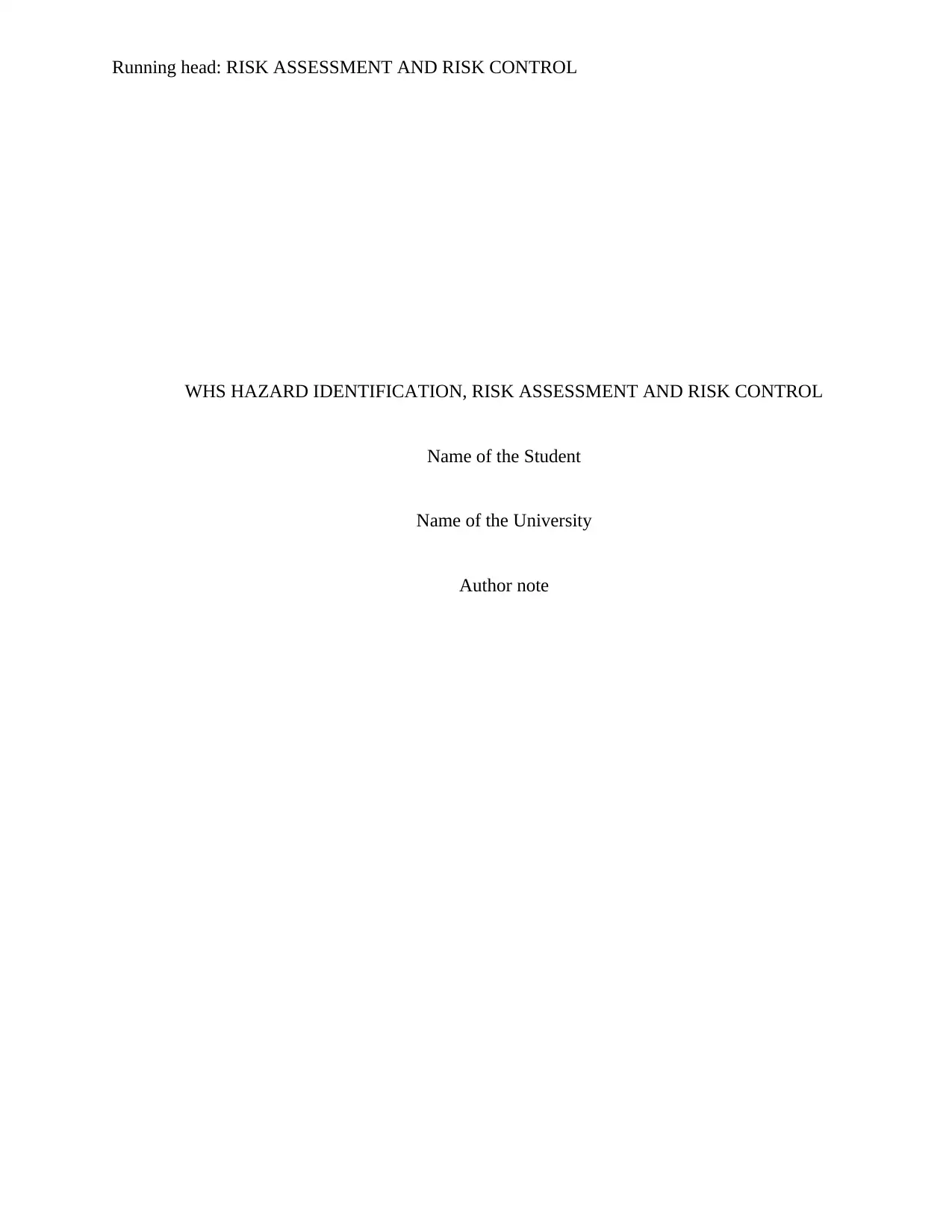
Running head: RISK ASSESSMENT AND RISK CONTROL
WHS HAZARD IDENTIFICATION, RISK ASSESSMENT AND RISK CONTROL
Name of the Student
Name of the University
Author note
WHS HAZARD IDENTIFICATION, RISK ASSESSMENT AND RISK CONTROL
Name of the Student
Name of the University
Author note
Paraphrase This Document
Need a fresh take? Get an instant paraphrase of this document with our AI Paraphraser
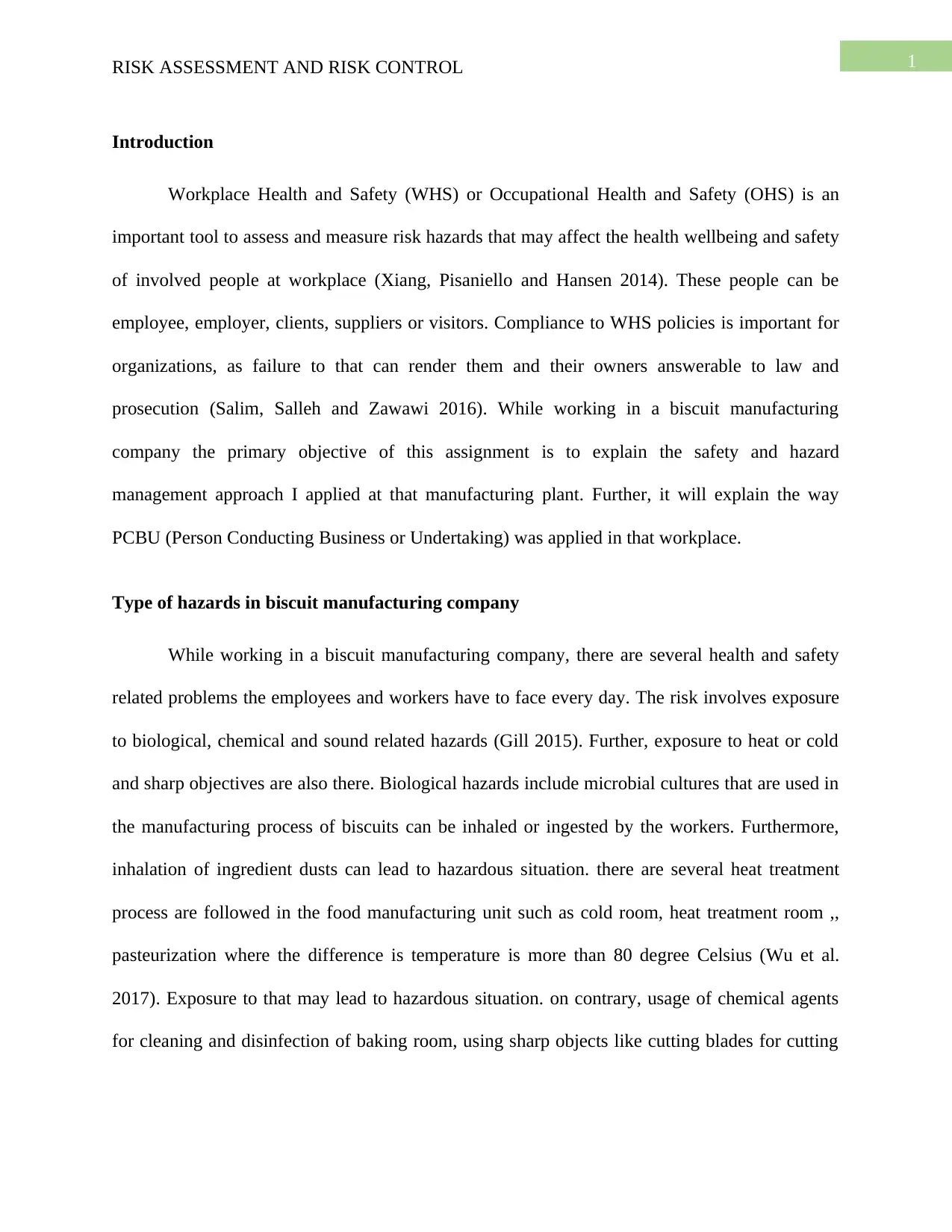
1RISK ASSESSMENT AND RISK CONTROL
Introduction
Workplace Health and Safety (WHS) or Occupational Health and Safety (OHS) is an
important tool to assess and measure risk hazards that may affect the health wellbeing and safety
of involved people at workplace (Xiang, Pisaniello and Hansen 2014). These people can be
employee, employer, clients, suppliers or visitors. Compliance to WHS policies is important for
organizations, as failure to that can render them and their owners answerable to law and
prosecution (Salim, Salleh and Zawawi 2016). While working in a biscuit manufacturing
company the primary objective of this assignment is to explain the safety and hazard
management approach I applied at that manufacturing plant. Further, it will explain the way
PCBU (Person Conducting Business or Undertaking) was applied in that workplace.
Type of hazards in biscuit manufacturing company
While working in a biscuit manufacturing company, there are several health and safety
related problems the employees and workers have to face every day. The risk involves exposure
to biological, chemical and sound related hazards (Gill 2015). Further, exposure to heat or cold
and sharp objectives are also there. Biological hazards include microbial cultures that are used in
the manufacturing process of biscuits can be inhaled or ingested by the workers. Furthermore,
inhalation of ingredient dusts can lead to hazardous situation. there are several heat treatment
process are followed in the food manufacturing unit such as cold room, heat treatment room ,,
pasteurization where the difference is temperature is more than 80 degree Celsius (Wu et al.
2017). Exposure to that may lead to hazardous situation. on contrary, usage of chemical agents
for cleaning and disinfection of baking room, using sharp objects like cutting blades for cutting
Introduction
Workplace Health and Safety (WHS) or Occupational Health and Safety (OHS) is an
important tool to assess and measure risk hazards that may affect the health wellbeing and safety
of involved people at workplace (Xiang, Pisaniello and Hansen 2014). These people can be
employee, employer, clients, suppliers or visitors. Compliance to WHS policies is important for
organizations, as failure to that can render them and their owners answerable to law and
prosecution (Salim, Salleh and Zawawi 2016). While working in a biscuit manufacturing
company the primary objective of this assignment is to explain the safety and hazard
management approach I applied at that manufacturing plant. Further, it will explain the way
PCBU (Person Conducting Business or Undertaking) was applied in that workplace.
Type of hazards in biscuit manufacturing company
While working in a biscuit manufacturing company, there are several health and safety
related problems the employees and workers have to face every day. The risk involves exposure
to biological, chemical and sound related hazards (Gill 2015). Further, exposure to heat or cold
and sharp objectives are also there. Biological hazards include microbial cultures that are used in
the manufacturing process of biscuits can be inhaled or ingested by the workers. Furthermore,
inhalation of ingredient dusts can lead to hazardous situation. there are several heat treatment
process are followed in the food manufacturing unit such as cold room, heat treatment room ,,
pasteurization where the difference is temperature is more than 80 degree Celsius (Wu et al.
2017). Exposure to that may lead to hazardous situation. on contrary, usage of chemical agents
for cleaning and disinfection of baking room, using sharp objects like cutting blades for cutting
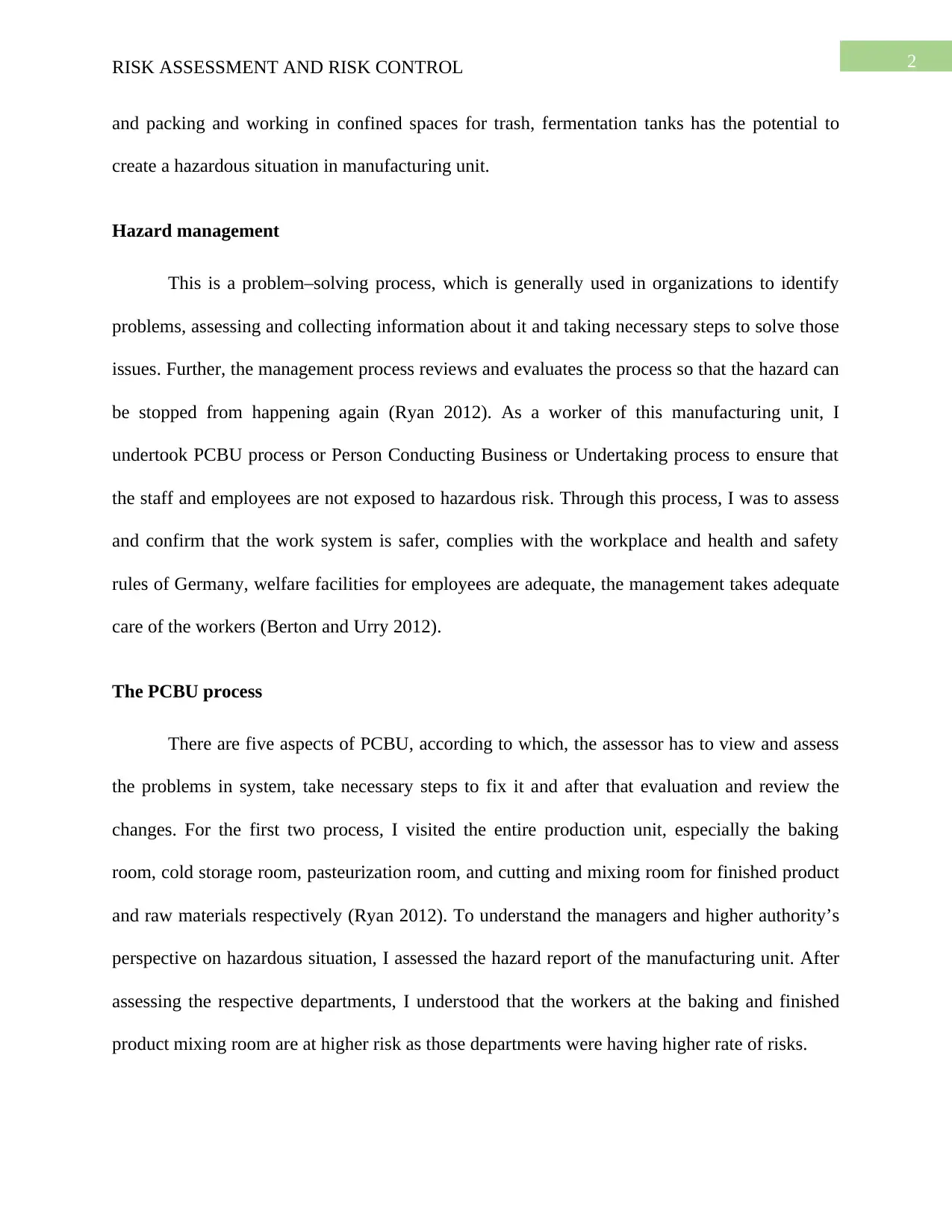
2RISK ASSESSMENT AND RISK CONTROL
and packing and working in confined spaces for trash, fermentation tanks has the potential to
create a hazardous situation in manufacturing unit.
Hazard management
This is a problem–solving process, which is generally used in organizations to identify
problems, assessing and collecting information about it and taking necessary steps to solve those
issues. Further, the management process reviews and evaluates the process so that the hazard can
be stopped from happening again (Ryan 2012). As a worker of this manufacturing unit, I
undertook PCBU process or Person Conducting Business or Undertaking process to ensure that
the staff and employees are not exposed to hazardous risk. Through this process, I was to assess
and confirm that the work system is safer, complies with the workplace and health and safety
rules of Germany, welfare facilities for employees are adequate, the management takes adequate
care of the workers (Berton and Urry 2012).
The PCBU process
There are five aspects of PCBU, according to which, the assessor has to view and assess
the problems in system, take necessary steps to fix it and after that evaluation and review the
changes. For the first two process, I visited the entire production unit, especially the baking
room, cold storage room, pasteurization room, and cutting and mixing room for finished product
and raw materials respectively (Ryan 2012). To understand the managers and higher authority’s
perspective on hazardous situation, I assessed the hazard report of the manufacturing unit. After
assessing the respective departments, I understood that the workers at the baking and finished
product mixing room are at higher risk as those departments were having higher rate of risks.
and packing and working in confined spaces for trash, fermentation tanks has the potential to
create a hazardous situation in manufacturing unit.
Hazard management
This is a problem–solving process, which is generally used in organizations to identify
problems, assessing and collecting information about it and taking necessary steps to solve those
issues. Further, the management process reviews and evaluates the process so that the hazard can
be stopped from happening again (Ryan 2012). As a worker of this manufacturing unit, I
undertook PCBU process or Person Conducting Business or Undertaking process to ensure that
the staff and employees are not exposed to hazardous risk. Through this process, I was to assess
and confirm that the work system is safer, complies with the workplace and health and safety
rules of Germany, welfare facilities for employees are adequate, the management takes adequate
care of the workers (Berton and Urry 2012).
The PCBU process
There are five aspects of PCBU, according to which, the assessor has to view and assess
the problems in system, take necessary steps to fix it and after that evaluation and review the
changes. For the first two process, I visited the entire production unit, especially the baking
room, cold storage room, pasteurization room, and cutting and mixing room for finished product
and raw materials respectively (Ryan 2012). To understand the managers and higher authority’s
perspective on hazardous situation, I assessed the hazard report of the manufacturing unit. After
assessing the respective departments, I understood that the workers at the baking and finished
product mixing room are at higher risk as those departments were having higher rate of risks.
⊘ This is a preview!⊘
Do you want full access?
Subscribe today to unlock all pages.

Trusted by 1+ million students worldwide
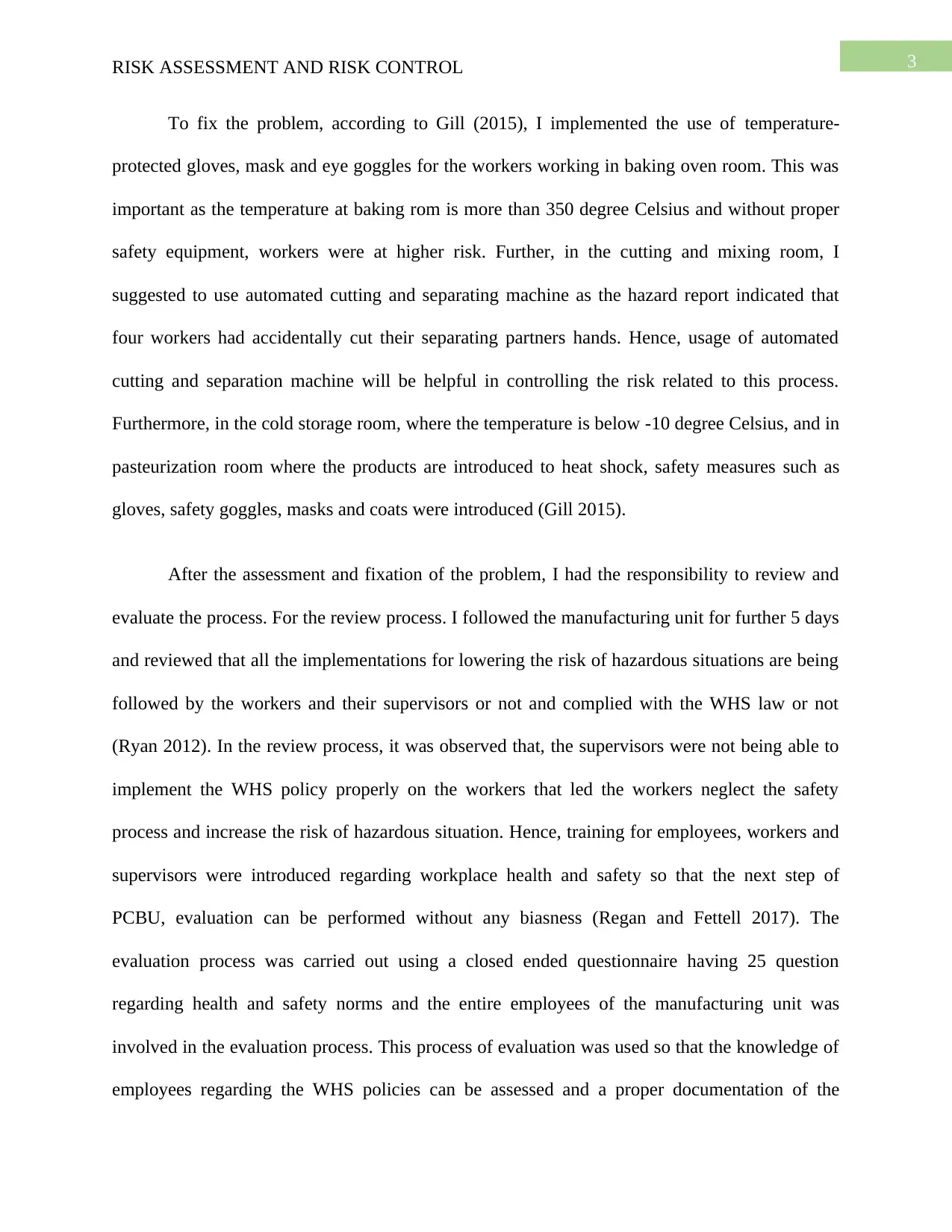
3RISK ASSESSMENT AND RISK CONTROL
To fix the problem, according to Gill (2015), I implemented the use of temperature-
protected gloves, mask and eye goggles for the workers working in baking oven room. This was
important as the temperature at baking rom is more than 350 degree Celsius and without proper
safety equipment, workers were at higher risk. Further, in the cutting and mixing room, I
suggested to use automated cutting and separating machine as the hazard report indicated that
four workers had accidentally cut their separating partners hands. Hence, usage of automated
cutting and separation machine will be helpful in controlling the risk related to this process.
Furthermore, in the cold storage room, where the temperature is below -10 degree Celsius, and in
pasteurization room where the products are introduced to heat shock, safety measures such as
gloves, safety goggles, masks and coats were introduced (Gill 2015).
After the assessment and fixation of the problem, I had the responsibility to review and
evaluate the process. For the review process. I followed the manufacturing unit for further 5 days
and reviewed that all the implementations for lowering the risk of hazardous situations are being
followed by the workers and their supervisors or not and complied with the WHS law or not
(Ryan 2012). In the review process, it was observed that, the supervisors were not being able to
implement the WHS policy properly on the workers that led the workers neglect the safety
process and increase the risk of hazardous situation. Hence, training for employees, workers and
supervisors were introduced regarding workplace health and safety so that the next step of
PCBU, evaluation can be performed without any biasness (Regan and Fettell 2017). The
evaluation process was carried out using a closed ended questionnaire having 25 question
regarding health and safety norms and the entire employees of the manufacturing unit was
involved in the evaluation process. This process of evaluation was used so that the knowledge of
employees regarding the WHS policies can be assessed and a proper documentation of the
To fix the problem, according to Gill (2015), I implemented the use of temperature-
protected gloves, mask and eye goggles for the workers working in baking oven room. This was
important as the temperature at baking rom is more than 350 degree Celsius and without proper
safety equipment, workers were at higher risk. Further, in the cutting and mixing room, I
suggested to use automated cutting and separating machine as the hazard report indicated that
four workers had accidentally cut their separating partners hands. Hence, usage of automated
cutting and separation machine will be helpful in controlling the risk related to this process.
Furthermore, in the cold storage room, where the temperature is below -10 degree Celsius, and in
pasteurization room where the products are introduced to heat shock, safety measures such as
gloves, safety goggles, masks and coats were introduced (Gill 2015).
After the assessment and fixation of the problem, I had the responsibility to review and
evaluate the process. For the review process. I followed the manufacturing unit for further 5 days
and reviewed that all the implementations for lowering the risk of hazardous situations are being
followed by the workers and their supervisors or not and complied with the WHS law or not
(Ryan 2012). In the review process, it was observed that, the supervisors were not being able to
implement the WHS policy properly on the workers that led the workers neglect the safety
process and increase the risk of hazardous situation. Hence, training for employees, workers and
supervisors were introduced regarding workplace health and safety so that the next step of
PCBU, evaluation can be performed without any biasness (Regan and Fettell 2017). The
evaluation process was carried out using a closed ended questionnaire having 25 question
regarding health and safety norms and the entire employees of the manufacturing unit was
involved in the evaluation process. This process of evaluation was used so that the knowledge of
employees regarding the WHS policies can be assessed and a proper documentation of the
Paraphrase This Document
Need a fresh take? Get an instant paraphrase of this document with our AI Paraphraser
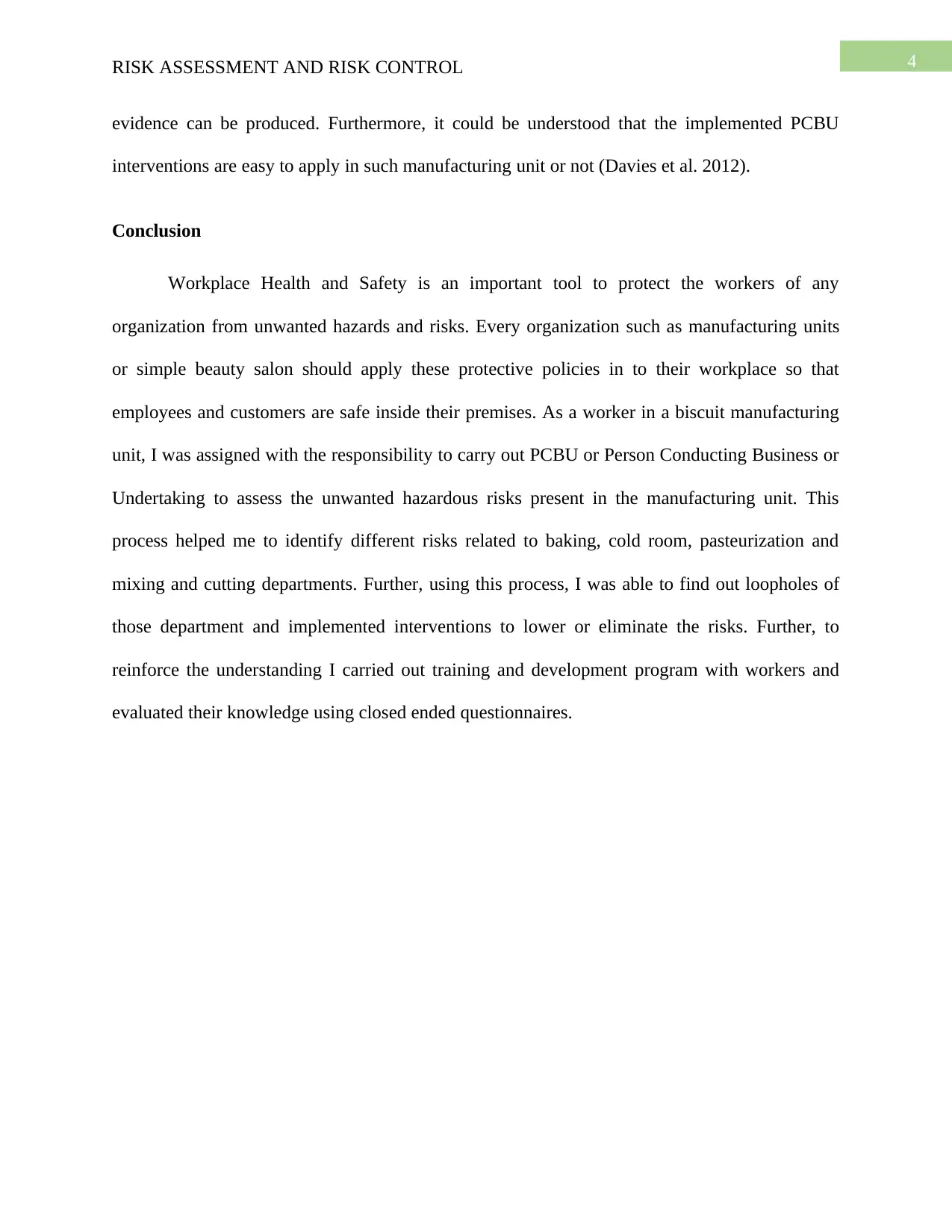
4RISK ASSESSMENT AND RISK CONTROL
evidence can be produced. Furthermore, it could be understood that the implemented PCBU
interventions are easy to apply in such manufacturing unit or not (Davies et al. 2012).
Conclusion
Workplace Health and Safety is an important tool to protect the workers of any
organization from unwanted hazards and risks. Every organization such as manufacturing units
or simple beauty salon should apply these protective policies in to their workplace so that
employees and customers are safe inside their premises. As a worker in a biscuit manufacturing
unit, I was assigned with the responsibility to carry out PCBU or Person Conducting Business or
Undertaking to assess the unwanted hazardous risks present in the manufacturing unit. This
process helped me to identify different risks related to baking, cold room, pasteurization and
mixing and cutting departments. Further, using this process, I was able to find out loopholes of
those department and implemented interventions to lower or eliminate the risks. Further, to
reinforce the understanding I carried out training and development program with workers and
evaluated their knowledge using closed ended questionnaires.
evidence can be produced. Furthermore, it could be understood that the implemented PCBU
interventions are easy to apply in such manufacturing unit or not (Davies et al. 2012).
Conclusion
Workplace Health and Safety is an important tool to protect the workers of any
organization from unwanted hazards and risks. Every organization such as manufacturing units
or simple beauty salon should apply these protective policies in to their workplace so that
employees and customers are safe inside their premises. As a worker in a biscuit manufacturing
unit, I was assigned with the responsibility to carry out PCBU or Person Conducting Business or
Undertaking to assess the unwanted hazardous risks present in the manufacturing unit. This
process helped me to identify different risks related to baking, cold room, pasteurization and
mixing and cutting departments. Further, using this process, I was able to find out loopholes of
those department and implemented interventions to lower or eliminate the risks. Further, to
reinforce the understanding I carried out training and development program with workers and
evaluated their knowledge using closed ended questionnaires.
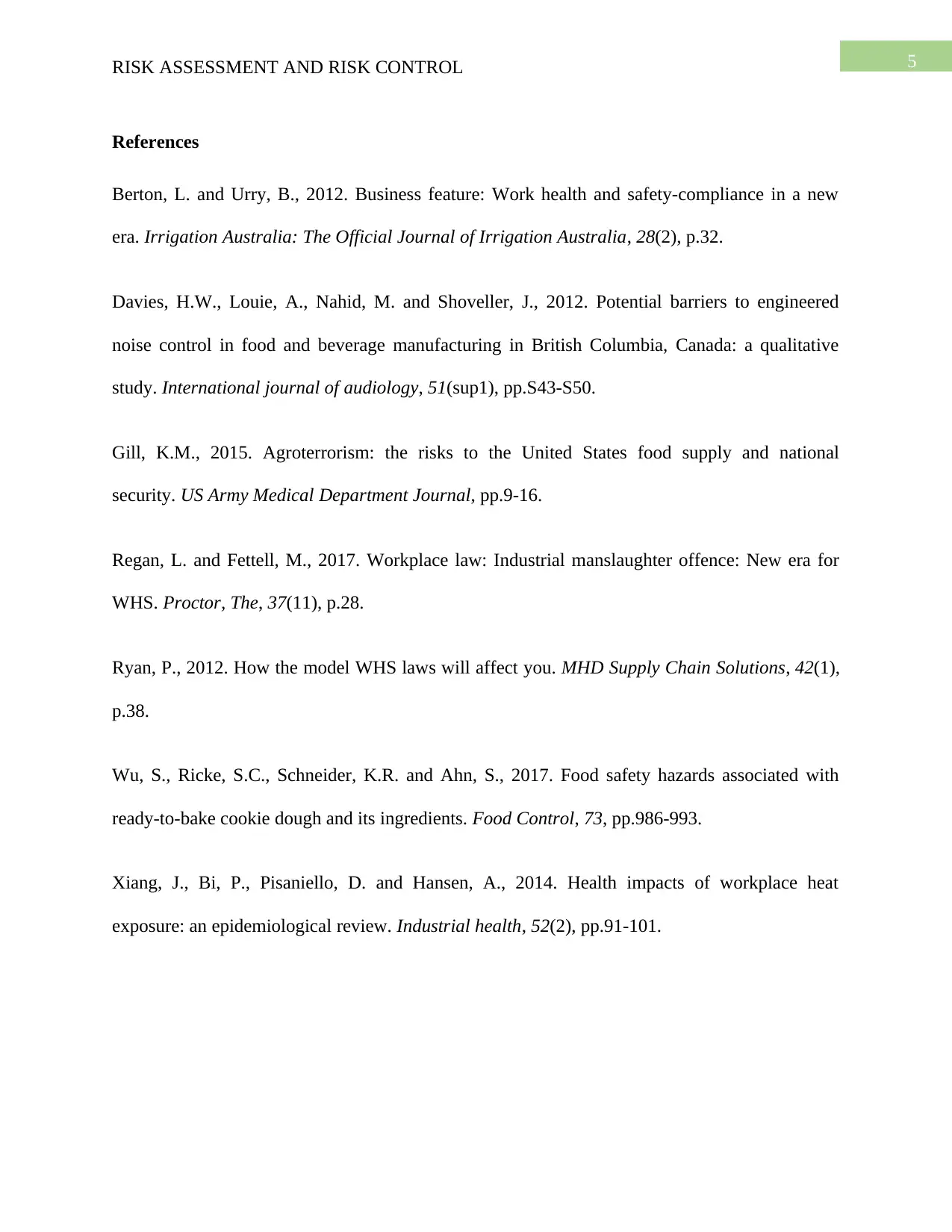
5RISK ASSESSMENT AND RISK CONTROL
References
Berton, L. and Urry, B., 2012. Business feature: Work health and safety-compliance in a new
era. Irrigation Australia: The Official Journal of Irrigation Australia, 28(2), p.32.
Davies, H.W., Louie, A., Nahid, M. and Shoveller, J., 2012. Potential barriers to engineered
noise control in food and beverage manufacturing in British Columbia, Canada: a qualitative
study. International journal of audiology, 51(sup1), pp.S43-S50.
Gill, K.M., 2015. Agroterrorism: the risks to the United States food supply and national
security. US Army Medical Department Journal, pp.9-16.
Regan, L. and Fettell, M., 2017. Workplace law: Industrial manslaughter offence: New era for
WHS. Proctor, The, 37(11), p.28.
Ryan, P., 2012. How the model WHS laws will affect you. MHD Supply Chain Solutions, 42(1),
p.38.
Wu, S., Ricke, S.C., Schneider, K.R. and Ahn, S., 2017. Food safety hazards associated with
ready-to-bake cookie dough and its ingredients. Food Control, 73, pp.986-993.
Xiang, J., Bi, P., Pisaniello, D. and Hansen, A., 2014. Health impacts of workplace heat
exposure: an epidemiological review. Industrial health, 52(2), pp.91-101.
References
Berton, L. and Urry, B., 2012. Business feature: Work health and safety-compliance in a new
era. Irrigation Australia: The Official Journal of Irrigation Australia, 28(2), p.32.
Davies, H.W., Louie, A., Nahid, M. and Shoveller, J., 2012. Potential barriers to engineered
noise control in food and beverage manufacturing in British Columbia, Canada: a qualitative
study. International journal of audiology, 51(sup1), pp.S43-S50.
Gill, K.M., 2015. Agroterrorism: the risks to the United States food supply and national
security. US Army Medical Department Journal, pp.9-16.
Regan, L. and Fettell, M., 2017. Workplace law: Industrial manslaughter offence: New era for
WHS. Proctor, The, 37(11), p.28.
Ryan, P., 2012. How the model WHS laws will affect you. MHD Supply Chain Solutions, 42(1),
p.38.
Wu, S., Ricke, S.C., Schneider, K.R. and Ahn, S., 2017. Food safety hazards associated with
ready-to-bake cookie dough and its ingredients. Food Control, 73, pp.986-993.
Xiang, J., Bi, P., Pisaniello, D. and Hansen, A., 2014. Health impacts of workplace heat
exposure: an epidemiological review. Industrial health, 52(2), pp.91-101.
⊘ This is a preview!⊘
Do you want full access?
Subscribe today to unlock all pages.

Trusted by 1+ million students worldwide
1 out of 6
Related Documents
Your All-in-One AI-Powered Toolkit for Academic Success.
+13062052269
info@desklib.com
Available 24*7 on WhatsApp / Email
![[object Object]](/_next/static/media/star-bottom.7253800d.svg)
Unlock your academic potential
Copyright © 2020–2025 A2Z Services. All Rights Reserved. Developed and managed by ZUCOL.





